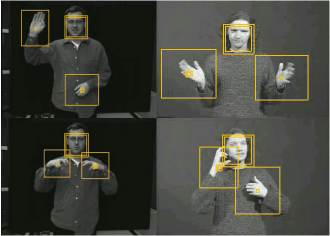Boosting is a general method that can be used for improving the
accuracy of a given learning algorithm [3]. More specifically, it is based on the
principle that a highly accurate or "strong" classifier can be produced through
the linear combination of many inaccurate or "weak" classifiers.
Classifier efficiency is increased by organising the weak
classifiers into a ‘cascade’, where the number of weak classifiers in each layer
of the cascade increases with depth. The purpose of this is that initial layers (which are
required to test many possible hypotheses) are simple to compute. They should reject large
numbers of hypotheses such that later layers (which are more complex and therefore
computationally expensive) need only be applied to a small subset of the original
hypotheses. In this fashion an exhaustive search over all positions and scales is possible
as in excess of 90% of possible hypotheses can be rejected at each stage of the cascade.
| Model |
N' Layers |
Cascade Layers |
+ve Training Eg |
-ve Training Eg |
Head
Hands |
10
8 |
2,5,5,20,50,50,150,150,150,150
2,5,5,20,50,50,150,150 |
2500
2400 |
6000
6000 |
 In order to perform detection, we train two different
strong classifiers for the head and hands respectively. The details of which are given in
the table above. The entire image is searched over all position and scale. To perform
detection on a section of an image the weak classifiers are transformed such that they are
applied to that image section. If the image content does not contain the object of
interest (head or hands), it will be rejected by a particular layer on the cascade.
Otherwise it will filter down to the final layer to be accepted by it. The strongest
detected head and hand hypotheses are then passed to stage
I classification. The figure shows some sample images taken from 2 sequences with the
detected location of head and hands outlined.
In order to perform detection, we train two different
strong classifiers for the head and hands respectively. The details of which are given in
the table above. The entire image is searched over all position and scale. To perform
detection on a section of an image the weak classifiers are transformed such that they are
applied to that image section. If the image content does not contain the object of
interest (head or hands), it will be rejected by a particular layer on the cascade.
Otherwise it will filter down to the final layer to be accepted by it. The strongest
detected head and hand hypotheses are then passed to stage
I classification. The figure shows some sample images taken from 2 sequences with the
detected location of head and hands outlined.
Signers generally face the viewer as directly as possible to ease
understanding and remove ambiguities and occlusions that occur at more oblique angles. The
system uses the boosted detectors coupled with a contour model of the head and shoulders.
This provides a bodycentred co-ordinate system in which to describe the position and
motion of the hands. The 2D contour is a coarse approximation to the shape of the
shoulders and head and consists of 18 connected points. The contour is a mathematical mean
shape taken from a number of sample images of signers.
The contour is fitted to the image by estimating the similarity
transform which minimises the contour's distance to local image features. Estimates for
key body locations, are placed relative to the location of the head contour. This means
that as the contour is transformed to fit the location of the user within the video
stream, so the approximate locations of the key body components are also transformed.
 In order to perform detection, we train two different
strong classifiers for the head and hands respectively. The details of which are given in
the table above. The entire image is searched over all position and scale. To perform
detection on a section of an image the weak classifiers are transformed such that they are
applied to that image section. If the image content does not contain the object of
interest (head or hands), it will be rejected by a particular layer on the cascade.
Otherwise it will filter down to the final layer to be accepted by it. The strongest
detected head and hand hypotheses are then passed to stage
I classification. The figure shows some sample images taken from 2 sequences with the
detected location of head and hands outlined.
In order to perform detection, we train two different
strong classifiers for the head and hands respectively. The details of which are given in
the table above. The entire image is searched over all position and scale. To perform
detection on a section of an image the weak classifiers are transformed such that they are
applied to that image section. If the image content does not contain the object of
interest (head or hands), it will be rejected by a particular layer on the cascade.
Otherwise it will filter down to the final layer to be accepted by it. The strongest
detected head and hand hypotheses are then passed to stage
I classification. The figure shows some sample images taken from 2 sequences with the
detected location of head and hands outlined.